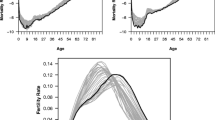Abstract
This paper discusses twostochastic time-series models developed recently for projecting age-specific fertility rates: the CARIMA model and the APC-ARIMA model. The forecasting performance of both models is examined using Dutch data. Alternatively, adeterministic time-series model is presented in which the age pattern of changes in the age-specific fertility rates between successive years is described by a cubic spline function. The model is capable of describing widely varying patterns. The model is applied to age-specific fertility rates for four countries: the Netherlands, England and Wales, Sweden and Australia.
Résumé
Cet article traite de deux modèles stochastiques qui utilisent des séries chronologiques: le modèle CARIMA et le modèle APC-ARIMA qui ont été développés récemment pour projeter les taux de fécondité par âge. La qualité des projections réalisées avec ces deux modèles est testée sur des données hollandaises. Simultanément, un modèle déterministe est présenté dans lequel les changements des taux de fécondité par âge entre années successives sont décrits par une fonction du troisième degré. Ce modèle est capable de décrire des situations qui varient dans un très large domaine. Il est appliqué aux taux de fécondité par âge de quatre pays: la Hollande, l'Angleterre et le Pays de Galles, la Suède et l'Australie.
Similar content being viewed by others
References
Abraham, B. and J. Ledolter, 1986, Forecast functions implied by autoregressive integrated moving average models and other related forecast procedures, International Statistical Review 54, 51–66.
Box, G.E.P. and G.M. Jenkins, 1970, Time series analysis, Forecasting and control (Holden-Day, San Francisco, CA).
Coppersmith, L.W., 1983, Forecasting time series which are inherently discontinuous, Journal of Forecasting 2, 225–235.
De Beer, J., 1985, A time series model for cohort data, Journal of the American Statistical Association 80, 525–530.
De Beer, J., 1988a, Predictability of demographic variables in the short run, European Journal of Population 4, 283–296.
De Beer, J., 1988b, Time series models for forecasting fertility, Paper presented at the International Workshop on National Population Projections.
Hoem, J.M., D. Madsen, J.L. Nielsen, E. Ohlsen, H.O. Hansen and B. Rennermalm, 1981, Experiments in modelling recent Danish fertility curves, Demography 18, 231–244.
Lee, R.D., 1974, Forecasting births in post-transition populations: Stochastic renewal with serially correlated fertility, Journal of the American Statistical Association 69, 607–617.
McDonald, J., 1979, A time series approach to forecast Australian total live births, Demography 16, 575–602.
McNeil, D.R., T.J. Trussell and J.C. Tumer, 1977, Spline interpolation of demographic data, Demography 10, 351–365.
Saboia, J.L.M., 1977, Autoregressive integrated moving average (ARIMA) models for birth forecasting, Journal of the American Statistical Association 72, 264–270.
Thompson, P.A., W. Bell, J. Long and R.B. Miller, 1987, Multivariate time series projections of parameterized age-specific fertility rates, Working paper 87-3, Ohio State University, Columbus, OH.
Willekens, F. and N, Baydar, 1984, Age-period-cohort models for forecasting fertility (Working paper no. 45, NIDI, The Hague).
Author information
Authors and Affiliations
Additional information
The views expressed in this paper are those of the author and do not necessarily reflect the policies of the Netherlands Central Bureau of Statistics.
Rights and permissions
About this article
Cite this article
de Beer, J. Projecting age-specific fertility rates by using time-series methods. Eur J Population 5, 315–346 (1989). https://doi.org/10.1007/BF01796791
Received:
Revised:
Issue Date:
DOI: https://doi.org/10.1007/BF01796791




